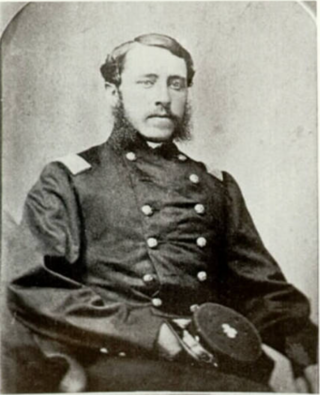
There were five corps in the Union Army designated as II Corps during the American Civil War. These formations were the Army of the Cumberland II Corps commanded by Thomas L. Crittenden from October 24, 1862, to November 5, 1862, later renumbered XXI Corps; the Army of the Mississippi II corps led by William T. Sherman from January 4, 1863, to January 12, 1863, renumbered XV Corps; Army of the Ohio II Corps commanded by Thomas L. Crittenden from September 29, 1862, to October 24, 1862, transferred to Army of the Cumberland; Army of Virginia II Corps led by Nathaniel P. Banks from June 26, 1862, to September 4, 1862, and Alpheus S. Williams from September 4, 1862, to September 12, 1862, renumbered XII Corps; and the Army of the Potomac II Corps from March 13, 1862, to June 28, 1865.

The 71st Regiment, Pennsylvania Volunteer Infantry was an infantry regiment of the Union Army that participated in the American Civil War.
The Philadelphia Brigade was a Union Army brigade that served in the American Civil War. It was raised primarily in the city of Philadelphia, Pennsylvania, with the exception of the 106th regiment which contained men from Lycoming and Bradford counties.

Norman Jonathan Hall was an officer in the United States Army during the American Civil War. He commanded the successful defense of his sector of the Union line against Pickett's Charge during the Battle of Gettysburg.
The 106th Pennsylvania was a volunteer infantry regiment which served in the Union Army during the American Civil War. It was part of the famous Philadelphia Brigade, which helped defend against Pickett's Charge in the Battle of Gettysburg.

The 118th Pennsylvania Regiment was a volunteer infantry regiment in the Union Army during the American Civil War. They participated in several major conflicts during the war including the Battle of Gettysburg, Siege of Petersburg, and escorted the truce flag of Robert E. Lee at the Battle of Five Forks. The regiment was led by Colonel Charles Prevost until he was seriously injured at the Battle of Shepherdstown in which Lieutenant-Colonel James Gwyn assumed command until the end of the war.

The 5th Michigan Infantry Regiment was an infantry regiment from Michigan that served in the Union Army during the American Civil War. The regiment was mustered into federal service in August 1861 and served in the Eastern Theater. It fought in all the major battles of the Army of the Potomac, including Seven Pines, the Seven Days Battles, Second Bull Run, Chantilly, Antietam, Fredericksburg, Chancellorsville, Gettysburg, the Wilderness, Spotsylvania, Cold Harbor, Petersburg, and Appomattox. The regiment was mustered out in June 1865.

Ezra Ayers Carman was an officer in the Union Army during the American Civil War, commanding a New Jersey infantry regiment and (occasionally) a brigade.

William Stowell Tilton was an American businessman and soldier who led a regiment, and occasionally a brigade, in the Army of the Potomac during the American Civil War. He and his men were heavily engaged in the Battle of Gettysburg, where Tilton's performance created controversy.

The 42nd New York Infantry Regiment, also called the Tammany Regiment, was a regiment of the Union Army during the American Civil War which was formed up in mid-1861 and mustered in on June 22, 1861. It was organized by the Tammany Club, a New York Democratic Party club.

The 125th New York Infantry Regiment was a volunteer regiment from Rensselaer County, New York, during the American Civil War. Formed during the summer of 1862, the unit was officially mustered into United States Service on 27–29 August 1862, by Col. George L. Willard. He had seen previous service in the Mexican War as well. Levin Crandall was commissioned lieutenant colonel, and James C. Bush major. The unit was mustered out on 5 June 1865.
The 1st Maryland Infantry Regiment, Potomac Home Brigade was an infantry regiment that served in the Union Army during the American Civil War.

The 64th New York Infantry Regiment, the "First Cattaraugus Regiment", was an infantry regiment of the Union Army during the American Civil War.

The 82nd New York Infantry Regiment, the "Second Militia," "Second Regiment N. Y. S. Light Infantry," or "State Guards", was an infantry regiment of the Union Army during the American Civil War.

The 57th New York Infantry Regiment was an infantry regiment in the Union Army during the American Civil War.

The 66th New York Infantry Regiment was an infantry regiment in the Union Army during the American Civil War.

The 108th New York Infantry Regiment was an infantry regiment in the Union Army during the American Civil War.

The 76th New York Infantry Regiment was an infantry regiment in the Union Army during the American Civil War.

The 100th Regiment Pennsylvania Volunteer Infantry was an infantry regiment that served in the Union Army during the American Civil War.

William Scott Worth was an American brigadier general of the American Civil War and the Spanish–American War. He was known for being the son of Major General William J. Worth and leading the 13th Infantry Regiment during the Battle of San Juan Hill.











